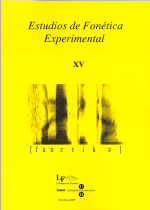Los grupos fricativa + nasal del polaco: realización sonora y fenómenos intermedios.
Keywords:
voicing, consonant clusters, polishAbstract
This paper presents the results of a phonetic study on the occurrence of transition elements in Polish fricative + nasal clusters. The acoustic study has been carried out using the CSL system with simultaneous observation of the waveform, spectrograph, glottal waveform and glottal pulses. The results reveal differences in glottal activity depending on the fricative place of articulation and in the fricative duration with respect to the extent of glottal vibration. Differences in the glottal activity pattern and the transition elements between the fricative and the nasal have also been observed. In the fricative-nasal limit three phenomena have been found: a voiceless interval, a voiced interval and the absence of the interval. It has also been observed that the occurrence and the characteristics of the transition interval depend on the place of articulation of the fricative.
References
BARRY, W. y H. KUNZEL (1978): «A note on the devoicing on nasals», Journal of the International Phonetics Association, 8, pp. 47-55.
BLADON, A. y A. AL-BAMERNI (1976): «Coarticulation resistance en English /l/», Journal of Phonetics, 4, pp. 137-150.
BURTON, M. W. y K.E. ROBBLEE (1997): «A phonetic analysis of voicing assimilation in Russian», Journal of Phonetics, 25, pp. 97-114.
CANELLADA, M. J. y J.K. MADSEN (1987): Pronunciación del español lengua hablada y literaria, Madrid, Castalia.
CASTELLVÍ, J. (2003): «Neutralization and Transparency Effects in Consonant Clusters in Polish», Proceedings of the 15 th International Congress of Phonetic Sciences, Barcelona, pp. 2765-2769.
CASTELLVÍ, J. y D. T. SZMIDT (2002): «Sobre la transparencia de las sonorantes en polaco», Actas del V Congreso de Lingüística General, Arco Libros, Madrid, pp. 599-607.
CUARTERO, N. (2001): Voicing Assimilation in Catalan and English, tesis doctoral, Universitat Autònoma de Barcelona.
DENT, H. (1984): «Coarticulated devoicing in E·nglish laterals», Works in progress, Reading University Phonetics Laboratory, 4, pp. 111-134.
DOCHERTY, G. J (1992): The timing of voicing in British English obstruents, Netherlands Phonetic Archives, Foris Publications.
HAGGARD, M. (1978): «The devoicing of voiced fricatives», Journal of Phonetics, 1, pp. 9-24.
HUTTERS, B. (1984): «Vocal fold adjustements in Danish voiceless obstruent production», Copenhagen, AIRPUC, 18, pp. 293-385.
KLATT, D. (1973): «Duration of pre-stressed word-initial consonant cluster in English», MIT Research Lab of Electronics Quarterly Progress Report, 108, pp. 253-260.
KLATT, D. (1975): «Voice onset time, frication, and aspiration in word-initial consonant clusters», Journal of Speech and Hearing Research, 18, pp. 686-705.
K , J. (1999): «Struktura segmentalna & ' (' polskiego realizowanych w czytanych listach wyrazowych», Speech and Language Technology, ) !
LABRAÑA, S. (2005): Estudio acústico das consoantes fricativas do galego, tesis doctoral, UB.
LADEFOGED, P. e I. MADDIESON (1996): The Sounds of the World’s Languages, Blackwell Publishers, Oxford.
LISKER, L. y A. S. ABRAMSON (1964): «A cross-language study of voicing in initial stops: acoustical measurements», Word, 20, pp. 384-422.
LISKER, L. y A. S. ABRAMSON (1967): «The Voicing Dimension: some experiments in comparative phonetics», Proceedings of the Sixth International Congress of Phonetic Sciences, Praga.
LÖFQVIST, A. y N. MCGARR (1987): «Laryngeal dynamics in voiceless consonant production», en T. Baer; C. Sasaki y K.S. Harris (eds.): Laryngeal function in fonation and respiration, Boston, College Hill, pp. 391-402.
MCGARR, N. y A. LÖFQVIST (1988): «Laryngeal kinematics of voiceless obstruents produced by hearing-impaired speakers», Journal of Speech and Hearing Research, 31, pp. 234-239.
OHALA, J. (1981): «Articulatory constraints on the cognitive representation of speech», en T. Myers; J. Laver y J. Anderson (eds): The Cognitive Representation of Speech, Amsterdam, North Holland, pp.111-122.
SAWICKA, I. (1995): «Fonologia», Gramatyka polskiego. Fonetyka y Fonologia, Cracovia.
SLIS, I.H. (1986): «Assimilation of voice in Dutch as a function of stress, word boundaries, and sex of speaker and listener», Journal of Phonetics, 14, pp. 311-326.
SNOEREN, N. D. y J. SEGUI (2003): «A Voice for the Voiceless: Voice Assimilation in French» Proceedings of the 15 th International Congress of Phonetic Sciences, Barcelona, pp. 2325-2328.
STEVENS, K.; S. BLUMSTEIN; S. GLICKSMAN; M. BURTON, y K. KUROWSKI (1992): «Acoustical and perceptual characteristics of voicing in fricativas and fricative clusters», Journal of the Acoustical Society of America, 91, pp. 2979-3000.
SUMMERFIELD, Q. (1975): «Aeromecánics versus mecanics in the control of voicing onset in consonant-vovel syllables», Speech Perception, 2(4), pp. 61-72.
ZUE, V. (1976): Acoustic Characteristics of Stop Consonants, Bloomington IN, Indiana University Linguistics Club.
Downloads
Published
How to Cite
Issue
Section
License

This work is licensed under a Creative Commons Attribution-NonCommercial-NoDerivatives 4.0 International License.
All articles published online by Estudios de Fonética Experimental are licensed under Creative Commons Attribution-NonCommercial-NoDerivs 4.0 International (CC BY-NC-ND 4.0 DEED), unless otherwise noted. Estudios de Fonética Experimental is an open access journal. Estudios de Fonética Experimental is hosted by RCUB (Revistes Científiques de la Universitat de Barcelona), powered by Open Journal Systems (OJS) software. The copyright is not transferred to the journal: authors hold the copyright and publishing rights without restrictions. The author is free to use and distribute pre and post-prints versions of his/her article. However, preprint versions are regarded as a work-in-progress version used as internal communication with the authors, and we prefer to share postprint versions.




